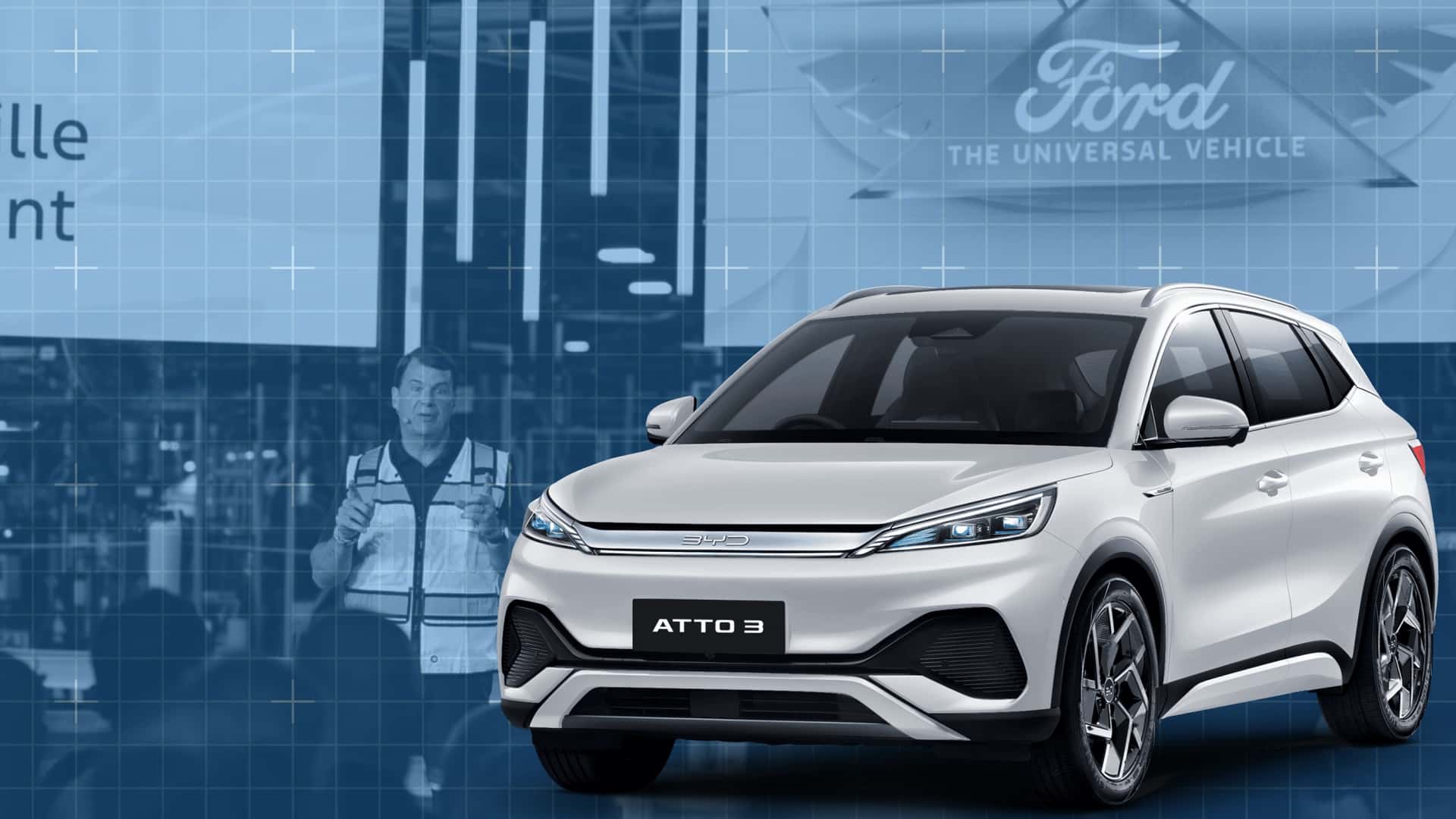
- The BYD Atto 3 is BYD's first model designed for global markets.
- Ford says its forthcoming EV truck will have 15% less usable battery than the "BYD Atto," which we think is the BYD Atto 3.
- BYD recently sold its millionth Atto 3 this year.
It doesn’t take a rocket scientist to realize that Chinese automaker BYD’s quest for world domination is going pretty well. Despite some roadblocks and a lack of presence in the United States or Canada, the brand has dominated electric vehicle sales in China and now other parts of the world. It's quickly become one of the world’s biggest automakers, and other car brands are taking notice.
Case in point: During Ford’s Kentucky-area speech and all through its materials, executives referenced the “BYD Atto” as a point of comparison—specifically that its new truck would have a battery 15% smaller than this model. But, what the hell is a BYD Atto? And why is it so important?
Well, as the resident China guy, I think I can help here. I’ve got my hands on more than a few Chinese market cars, including ones by BYD. And yes, I have driven the BYD Atto that Ford keeps mentioning. Here’s why Ford brought it up.
Gallery: BYD ATTO 3







What is a BYD Atto, and why is it so important?
Technically, there’s no model named “BYD Atto.” There are two small crossovers from BYD: the Atto 3 and the Atto 2, both of which are subcompact crossovers. I am assuming that Ford has the BYD Atto 3 on its mind, since the Atto 2 only went on sale in European markets a few weeks ago. In China, the Atto 3’s homegrown name is Yuan Plus. (It’s kind of ironic since the Yuan Plus replaced the Yuan Pro, which was a cloned Ford Ecosport with batteries.)
Some may wrongly compare the Atto 3 to the Tesla Model Y, but that’s a strange comparison. They’re similar in the sense that they’re both electric crossovers, but otherwise, they’re not similar at all. The Atto 3 is front-wheel-drive only, and about the same size and price as the previous generation Honda HR-V. By comparison, the Model Y’s somewhat upscale aspirations and all-wheel-drive option put it more of a BMW X3 contemporary, although I think BYD’s aspirational pricing put the Model Y and Atto 3 a little closer than they should be in foreign markets.
When Ford kept talking about how it said its new truck would have 15% less battery than the “BYD Atto (3)”, I wasn’t sure why Ford would even look to that model for inspiration. But since Ford’s goal is to make an affordable, simplified (but not stripped-down) truck and not another expensive spaceship, it starts to make sense.
If you look a the Atto 3’s specifications, they’re all kind of run-of-the-mill; only about 60 kWh of battery, only about 200 horsepower, FWD only, 400-volt architecture, and about 250 miles of range, depending on which rating cycle you choose to use as gospel. Its DC fast charging speed can only hit 88 kW, impressive in say, 2019. These specs aren’t all that groundbreaking, but I’d argue they don’t need to be, for Ford or for BYD.
The Atto 3 is important for BYD globally because the brand’s first real model design for export, and it’s been generally successful globally. Since its introduction, Atto 3/Yuan Plus has sold over one million units. It isn’t the most advanced EV on the market, but BYD managed to make a package that’s right-sized and pleasant to use—which seems to be what Ford wants to do too. I was able to get behind the wheel of an Atto 3 while at the Paris Motor Show back in 2022, and I was impressed at how well-resolved it was.
The exterior was sharp, and the interior felt fresh, even if I thought some details, like the rotating center screen or the guitar-inspired door pickets, were more on the side of whimsy rather than practicality. The crossover felt well assembled, and it went around corners about as well as any small crossover you’d be able to find in Europe.

It felt identical to basically any other small crossover available in Europe, a good thing for buyers who want fuss-free driving. A 10-minute drive around Paris, and I instantly understood why the car resonated so hard with customers and shocked so many non-Chinese auto executives.
Add in BYD’s vertical integration and modularity, and parts sharing between its products, and the Atto 3 seems like the perfect car to be inspired by. Much of the Atto 3’s under-the-skin parts are shared with other BYD models, like the new Atto 2, Dolphin, and even the Tesla Model 3-rivaling BYD Seal. It’s not a bad car to emulate, especially if the goal is to start a whole new model lineup and way of making cars from scratch.

My only real fear for Ford is that the brand has benchmarked a car that has already been surpassed. The Chinese market is not stagnant at all, and plenty of competitors have bested the Atto 3/Yuan Plus’s abilities in its home market. Heck, even BYD itself has recently updated the home market version of the Atto 3 with updated styling, a nicer interior and better software. BYD has also introduced several new models that are about the same size as the Atto 3, from slightly more upscale brands, like the Fangchengbao Tai 3.

Sure, a 400-volt architecture isn’t groundbreaking. But it’s probably fine when the goal is keeping costs down, especially since we haven’t quite yet seen a similar level of development from other U.S.-based carmakers. If this goes right, Ford could be sitting pretty for a long while.
Contact the author: Kevin.Williams@insideevs.com








